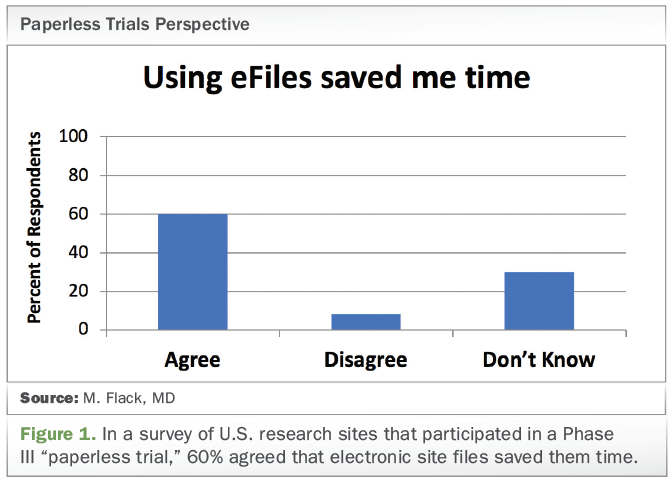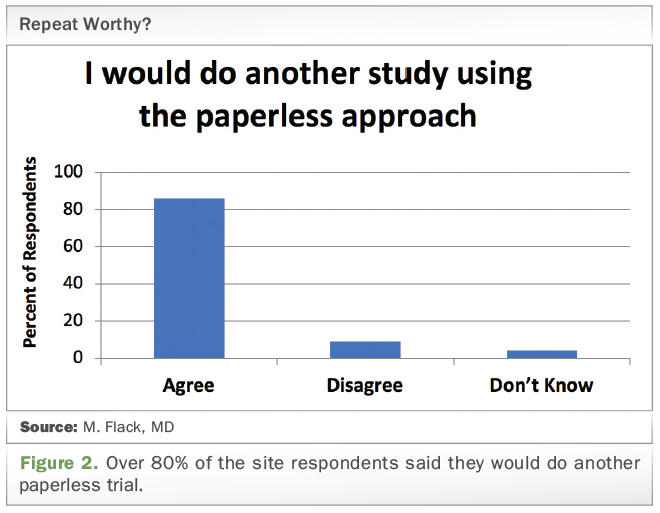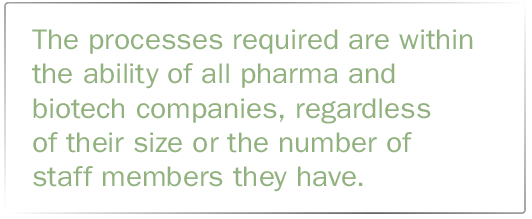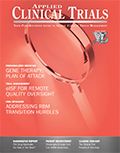Adopting eISF for Remote Quality Oversight of Trials
Applied Clinical Trials
Exploring the use of electronic investigator site files for review of regulatory documents and informed consents.

The adoption of using electronic systems in clinical research has been like watching a slow-moving train on a cross-country tour. Over the past 20 years, many technologies have been delivered with varying adoption rates. This underwhelming response came despite strong recommendations from FDA, European Medicines Agency (EMA), and International Council for Harmonization of Technical Requirements for Pharmaceuticals for Human Use (ICH) regulators that encouraged adopting systems such as electronic source records.
In 2018, Thomas Cocciardi reported in Clinical Leader1 that in the most recent inspection metrics by UK’s Medicines & Healthcare Products Regulatory Agency (MHRA), record keeping represented the single greatest category of major findings. He further reported that FDA’s Bioresearch Monitoring Program (BIMO) metrics for FY2016 showed inadequate record keeping as the most common deficiency at investigator sites. Cocciardi further described the investigator site file (ISF) as a poorly controlled and growing risk for sponsors and investigators.
For over 10 years, we have used an electronic Investigator site file (eISF) in addition to an electronic trial master file (eTMF). We have adopted special processes for access control, generating certified copies of documents collected in paper such as informed consents, subject source records, file structure, and archiving.
Good clinical practice guidance
Despite the myriad of benefits for adopting an eISF, sponsors cite the following issues for not adopting an eISF:
- Does an eISF that the sonsor pays for, but where the site has full control to upload and download documents, meet the regulatory requirements for an ISF?
- Can you store documents with protected health information (PHI) in an eISF?
To assist in answering these questions, I provided the information and posed these questions to the FDA Office of Good Clinical Practice (GCP) concerning use of an eISF as follows:
We use a cloud-based file solution configured using an existing electronic file sharing system. We have confirmed that the system meets 21 CFR Part 11 using our processes and the system’s features. We have configured this file system to be used to maintain the site’s regulatory documents in addition to the sponsor’s eTMF. These folders align with the DIA reference model for the eTMF.
- The folders have role-based access. Personal identifying information (e.g., certified copies of informed consents and investigator assessment of clinical significance on lab reports) is maintained in folders that are only accessible by the site staff, monitors, and auditors as stated in the informed consent.
- The file system is configured, tested, and user roles administered by the CRO. Only users with specific roles and at specific sites can access an individual site’s eISF.
- Site users, such as principal investigator (PI), sub-investigators, study coordinators (SCs), and any other staff members identified by the site) are granted access to their site’s folders and documents after completing training.
- The site staff can upload and download any document in their site’s folders. These documents include the site’s regulatory documents and all reference documents and training materials that have been provided to the site.
- At the end of the trial, all site documents are archived as PDF documents and the site is provided with an archive of its site’s files.
- Once the site archive is completed, the documents are merged into the eTMF for archiving of the entire eTMF.
- During the study, duplicative documents are not collected and maintained separately in two different systems (eISF and eTMF). Documents, such as the signed 1572, financial disclosures, and protocol signature pages are maintained in each site’s eISF for the duration of the trial. The sponsor and CRO have access to the site’s eISF (excluding any documents with subject personal identifying information) so all documents are available-but it assures that there is only one version in the study files for both the eTMF and the eISF.
The response we received from the FDA Office of Good Clinical Practice in 2016 was as follows: “Provided that your cloud-based file system meets 21 CFR part 11 controls (see 21 CFR 11.10 and 11.30) including the requirement that appropriate access controls be in place to limit access to authorized users (see 21 CFR 11.10(d)), we would find your approach acceptable for meeting FDA record keeping and record retention requirements (see 21 CFR 312.62).”
We raised a second question to the FDA in April 2019 of whether documents with PHI can be maintained in the eISF and whether redaction was required.
The following was our question:
Our current approach is to add language in the subject’s informed consent stating that the study staff, monitors, clinical trial associates, and auditors can view the subject’s documents with PHI and personally identifiable information (PII). We document that the documents are stored in the cloud and an archive will be made and provided to the investigative site, but not the sponsor.
We set up our eISF so that PHI/PII documents converted to certified electronic copies are managed in a separate workflow, including storage in files only accessible to the study staff (PI, SCs, regulatory), monitors, clinical trial associates (CTAs), and those performing QC (project manager and auditors).
The company providing the eTMF/eISF will sign a business associate agreement and follow all the setup for HIPAA documents in the Amazon Cloud. The archive for the sites will include the PHI/PII certified documents. PHI/PII documents are not provided in the eTMF.
Can you confirm that this process aligns with 21CFR Part 11, ICHE6R2, and HIPAA?
The Office of GCP provided the following response:
“We do not have specific requirements regarding the manner in which trial-related documents are stored. The applicant should ensure that the cloud service they use has the appropriate electronic safeguards on data security to ensure that these documents are only available to authorized users and that they cannot be modified or deleted within the record retention period.”
Technology and process requirements for using an eISF with an eTMF
We evaluated eTMF systems to determine if they could also be used for eISFs. Some companies said their system could not be used for eISFs. Others used workflows for converting documents to certified copies without an eSignature process, which is required in our processes. Other vendors were willing to work with us to implement our eISF process for automated management of eISFs. While automated systems are helpful for large trials and larger organizations, we have also implemented an eISF/eTMF solution with off-the-shelf software with electronic signatures and manual workflows.
The changes in process needed to implement an eISF include five critical workflows:
- Modify file structure from DIA reference model so sites have all the files they need for managing the entire study, not just folder 5.0 in the DIA Reference manual, and provide a repository for all documents used routinely in the study (e.g., protocols, training materials, lab manuals).
- Certify documents as electronic copies based on 21CFR Part 11 requirements.
- Electronic signature workflow for documents, including start up documents, to enable collection and filing automatically.
- Managing documents with PHI so sites do not have to de-identify documents with markers ever again.
- Separate archiving process for sponsor and site files.
eISF adoption
Adopting an eISF benefits everyone involved in study conduct.
Sites win because they save hours of time (e.g., printing documents for PI signature, scanning the documents for upload to eTMF, filing paper copies, copying documents multiple times), space in their facility, and long-term storage costs.

Sponsors win because they have full visibility into each site’s relevant regulatory documents-assuring they are always audit ready. Sponsors also win because the eTMF and eISF are completely aligned.
CROs win because they no longer need to set up and print millions of copies of documents for regulatory binders, so start-up is faster and more efficient. CROs do not need to send CRAs to the research site to review documents, including informed consents (which can be converted to certified electronic copies and reviewed remotely). CROs can now identify missing documents more easily than by reviewing paper regulatory binders.
Quality management teams wins because they can conduct audits remotely in a fraction of the time without travel, from anywhere in the world.
Our environment wins because fewer flights and auto travel are needed and billions of pages paper are saved.
But don’t take my word for it; the following were data presented at previous DIA meetings and poster presentations:
Site satisfaction
A survey was conducted of research sites that participated in a Phase III trial in the US using an eISF, eTMF, and eSource (i.e., a paperless trial). There were 15 sites that rapidly enrolled 788 subjects. Over 50% of the sites responded to the survey, including 80% of the PIs.
Among the benefits the sites cited for using an eISF were:
- Saving time and space (see Figure 1)
- All documents in one place, easy to access documents
- No paper regulatory binders
- Monitoring visits were easier
Over 80% of the sites responded that they would do another paperless trial. (see Figure 2)

Quality oversight of informed consents
Remote review of informed consents and audits were conducted quickly and efficiently.
ICF review: sites uploaded their consents into their site eISF within a median of five days after completion of the informed consent; review of the informed consent was completed in a median of three days. Only one remote staff member was needed to conduct the ICF review of the 788 subjects.
The one significant issue/trend for informed consents was identified within the first week of ICF review. It was an error in the document provided by the institutional review board (IRB). Training was implemented immediately to eliminate additional Informed consent errors and a new ICF was requested from the IRB.
Remote quality audit
An audit of 10% of the certified copies of informed consents took 16 hours for one remote staff member.
As these findings demonstrate, there is no evidence for not implementing a full paperless approach to clinical trial conduct and oversight.
Summary

eISFs are a powerful tool to support remote quality oversight of trials in real time. The processes required are within the ability of all pharma and biotech companies, regardless of their size or the number of staff members they have.
Key process changes are needed for the informed consent process, access control, certifying documents, and archiving. Whether off the shelf with electronic signatures or from technology vendors, the efficiencies and economic benefits of implementing remote regulatory and source document oversight can begin today.
Reference
1. Cocciardi, Thomas. “Bridging the ISF-TMF Divide: What Roles Should Sponsors and Investigators Play?” Clinical Leader. Published online April 10, 2018, https://www.clinicalleader.com/doc/bridging-the-isf-tmf-divide-what-roles-should-sponsors-investigators-play-0001
Penelope Manasco is the CEO of MANA UBM

Improving Relationships and Diversifying the Site Selection Process
April 17th 2025In this episode of the Applied Clinical Trials Podcast, Liz Beatty, co-founder and chief strategy officer, Inato, discusses a number of topics around site engagement including community-based sites, the role of technology in improving site/sponsor relationships, how increased operational costs are impacting the industry, and more.
Behind the Buzz: Why Clinical Research Leaders Flock to SCOPE Summit
February 7th 2025In this episode, we meet with Micah Lieberman, Executive Conference Director for SCOPE Summit (Summit for Clinical Ops Executives) at Cambridge Innovation Institute. We will dive deep into the critical role of collaboration within the clinical research ecosystem. How do we bring together diverse stakeholders—sponsors, CROs, clinical trial tech innovators, suppliers, patients, sites, advocacy organizations, investors, and non-profits—to share best practices in trial design, program planning, innovation, and clinical operations? We’ll explore why it’s vital for thought leaders to step beyond their own organizations and learn from others, exchanging ideas that drive advancements in clinical research. Additionally, we’ll discuss the pivotal role of scientific conferences like SCOPE Summit in fostering these essential connections and collaborations, helping shape the future of clinical trials. Join us as we uncover how collective wisdom and cross-industry partnerships are transforming the landscape of clinical research.